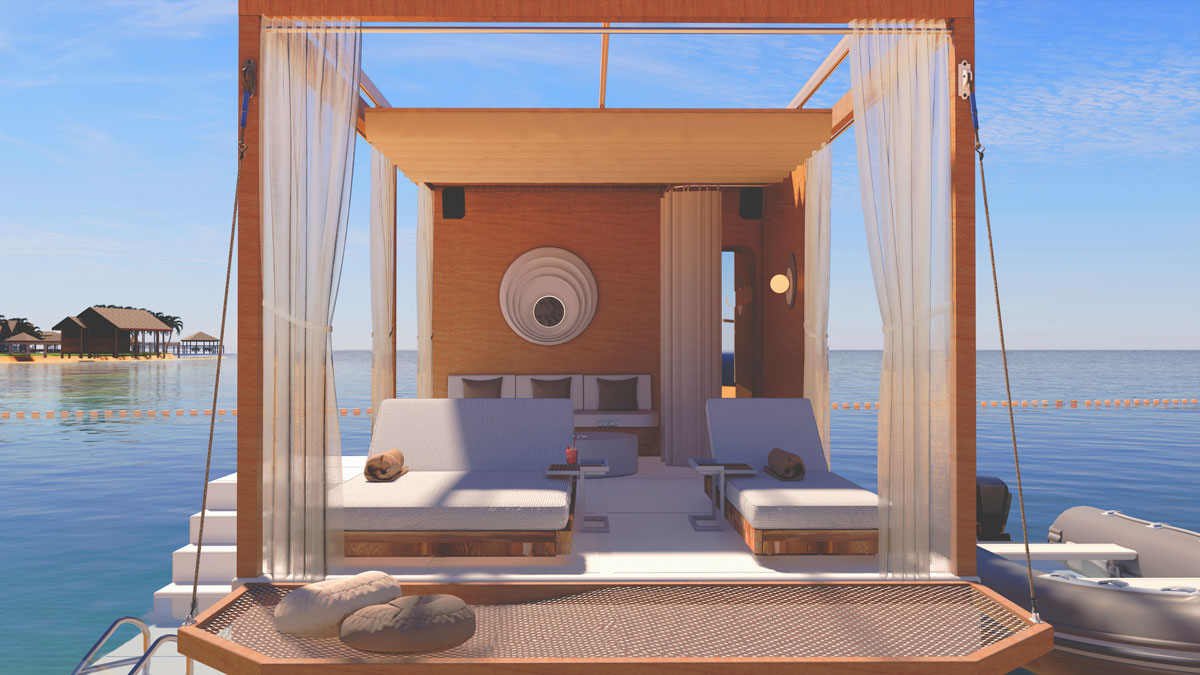
Beach holidays are no longer limited to the traditional trio of sea, sand, and sun. Today’s travelers crave unique experiences that blend relaxation with innovation. Enter the Floating Lounge, an innovative addition to waterfront properties [...]
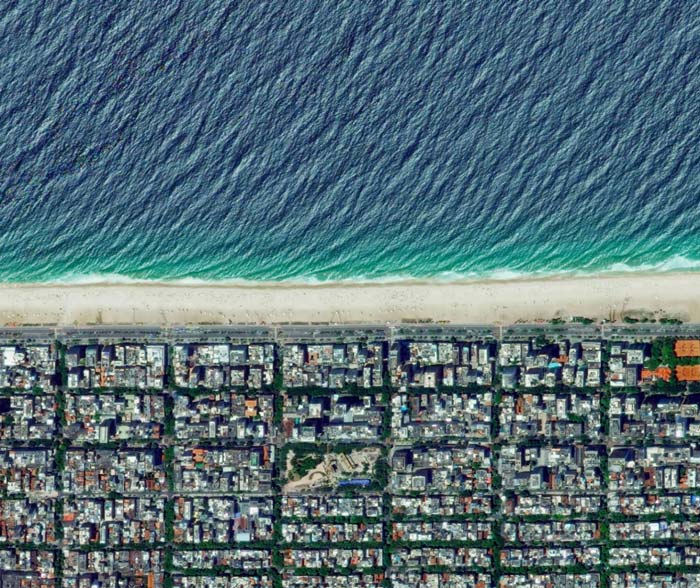
There is less and less space for expansion on the land. (Source: DigitalGlobe, Inc.)
About 90 percent of the world’s largest cities are located on the waterfront and are vulnerable to rising sea levels. In addition, more than a half of their built environment is yet to be built by 2050 to provide living spaces and infrastructure to increasing population. The question is where? Is there enough space on land for more settlements? Should we force more building on the land and compromise safety, livability, and sustainability? Or are these wrong questions? Let’s flip the perspective and look for the remedy in water surfaces whose limitless potential for living is yet to be discovered. In this article we will guide you through how and why building on water is the key to creating sustainable and resilient future.
We are living in times of rapid change and unanticipated crises. The population of the world’s urban areas is increasing by 200,000 people per day, according to the World Economic Forum. The United Nations forecasts that the overall growth of the world’s population could add another 2.5 billion people to urban areas by 2050 meaning that 60% of the built environment required to accommodate this growing population is yet to be built.
This is going to put enormous strain on the world’s existing metropolises, specifically those located on waterfronts. Two out of every five people in the world live within 100 kilometers of the coast, and the majority of mega cities worldwide are vulnerable to rising sea levels. Flooding is destroying infrastructure and forcing millions of people to leave their homes. The C40 network estimates that the cost of rising sea levels and inland flooding could reach $1 trillion by 2025.
These challenges are posing a question vital to humanity's future. How and where do we develop new settlements while easing the pressure on the Planet? Should we force more building on the land and compromise safety, livability, and sustainability? Can land handle more buildings and people, or is it time to think of different alternatives?
There are three possible scenarios for the future of cities:
As suggested by the World Bank, city growth can occur along three margins: horizontal spread extending beyond the city’s previously built-up area; infill development through closing gaps between existing structures in a city; and vertical layering which is raising the skyline of the existing built-up area. The major risk of this approach is that it might eventually lead to overbuilding and even poorer living conditions due to over crowdedness.
Land reclamation also called a ‘destructive force’ on world coastlines is a method used to create more land space for cities over the last five decades. Led by the conventional logic that the stability for a building can only be provided on the soil, this method adds new land by sacrificing a part of water. Examples of this approach can be found all over the world, from Monaco to Dubai. In Singapore, for example, 25% of the city is built on reclaimed land, whereas 20% of Tokyo is built on artificial islands constructed into the water. A recent study published in the journal Earth’s Future, shows that an area equivalent to the size of Luxembourg has been added to coastlines since 2000, not to forget sacrificing as much of the water surface in return. The study also shows that 70% of recent reclamation has occurred in areas identified as potentially exposed to extreme sea level rise by 2100 which presents a significant challenge to sustainable development at the coast.
It is no secret that reclamation is unsustainable solution leading to environmental degradation, endangering the biodiversity and balance of oceans and seas. Additionally, reclamation is using vast amounts of materials that are already in scarcity, such as sand, which is the most extracted resource on Earth, after water. It is also cost and time-inefficient procedure. It usually takes 7 to 10 years for final reclamation to be completed. And much of the new land does not last for long without re-filling, leaving it in need for continuous and costly maintenance to keep it stable.
The ‘bad reputation’ reclamation has gained through years contributed to the globally negative attitude towards the idea of building on water.
Water is going to be the next frontier of human development. The importance of water in the growth and development of human civilization can hardly be overstated. Since the first settlements on Earth, access to water has been a key defining factor in the location and prosperity of cities. Great civilizations were founded on the banks of oceans, rivers, and lakes. Water enabled agricultural activities, trade, and defense. Contemporary metropolitan cities like New York, Barcelona, Istanbul, Sydney, and Hong Kong are developed in the vicinity of water.
The interest in living on water and floating cities has long been present. The life on water was described in many visionary texts such as Jules Verne’s floating city in Une ville flottante. In the past few years, there has been a significant increase of interest in building on water showing that its potential has been globally recognized. Studies say that if 13% of the human population start to live on water, humanity will achieve harmony with nature. And only 1% of the total ocean area will be needed for that.
Universities and research institutes worldwide are searching for water-based solutions to housing crisis. A recent initiative by The United Nations begun to study how floating cities could be a viable solution to climate change and lack of affordable housing. The effort produced a speculative proposal for a floating city named Oceanix City that can accommodate 10,000 people and will organically change, expand, and adapt over time. However, many proposals made up to date are still far from reality and usually do not move beyond the conceptual level.
We always needed water and tended to be in its vicinity. Yet, we never ventured out and began subsisting on water. What was lacking is a durable solution capable of withstanding environmental conditions.
Today, for the first time in history, we can safely step up on water surface and form our settlements there thanks to the Floating Foundation System (FFS) developed by HSB Marine Construction.
Founded in Istanbul in 2006, HSB Marine Construction is an internationally renowned design, engineering, and construction company that is specialized in developing products and solutions on water. Based on the vision that we can create a sustainable future on water, we designed a system that will allow forming human settlements without compromising the life quality and comfort, safety, or natural environment. Carefully designed, engineered, and tested for the most extreme conditions, FFS is a unique method that enables floating on the water, providing a solid foundation for building almost any sort of structure on water.
Unlike reclamation method, that works against water, FFS works with water. It floats and can never sink because it is buoyed up by a force equal to the weight of water displaced by it, as Archimedes suggested centuries ago. Its cost and time effective production, and mobility makes it easily applicable in every part of the world. Unlike most of floating proposals made until today that are only conceptual, the FFS system represents the real-life actual solution that guarantees full stability on water surface. As such, FFS will be the key enabler of sustainable and systematic expansion of cities and their physical, social, and economic evolution while generating new forms of interaction and production on water.
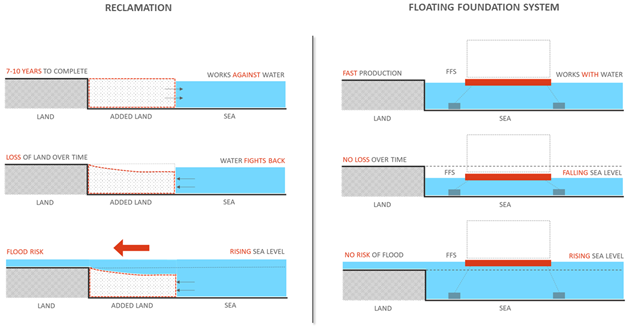
Reclamation vs. Floating Foundation System (FFS)
Adopting building on water approach will give the world's overpopulated urban centers more space to grow. FFS allows utilization of large areas of water close to city centers with minimal impact and high resilience to changing water levels while providing abundant opportunities for development.
FFS is designed to allow any type of building to be placed on the top of it. Modular approach in designing the FFS system allows endless number of combinations to meet various customers’ needs. Modularity also allows size adjustments, expansion or reduction of the size as needed. This also makes FFS adaptable to different use scenarios.
FFS is easily transportable to any desired location on the Earth. The same structure can then be moved between different locations and reused for different purposes. Modifying or dislocating the foundations on land are usually not possible without demolishing the building on it. However, as FFS is not attached to the ground, it can be easily dislocated with minimum modification of the foundation and building standing on it.
Compared to conventional construction methods, construction with FFS can take about half as long. FFS is produced off the site and then delivered to a specific location. The foundation and the building can be built simultaneously, remarkably accelerating the construction process. Time needed for the excavation and soil preparation procedures in building on land is not needed for the FFS.
The water underneath the FFS functions as a seismic damper, making it resistant to the effects of earthquakes. Additionally, FFS can never be submerged making it resilient to rising sea levels, extreme weather, and flooding.
The use of water space rather than land space can potentially result in a reduction in the overall rate of deforestation. Since it does not affect the seafloor or marine life, FFS represents environmentally friendly solution.
At HSB Marine, we are committed to developing floating solutions that will provide better living conditions on Earth. Our products are characterized by smart design, remarkable engineering and premium quality. In collaboration with visionary architects and engineers from around the world, we are beginning to shape the tradition of building on water. Over the past decade, we have been working with passion and devotion to our vision. And today, we are proud to say that we have designed and built the first and the largest artificial floating island on water. The first patent for this solution was built in front of Qatar’s iconic towers for the opening of FIFA World Cup.
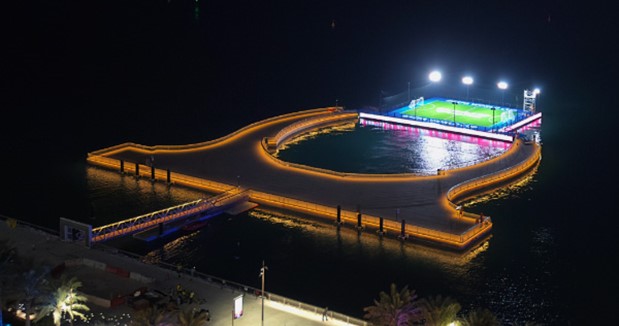
World's Largest Monolith Floating Structure, Doha, Qatar.
Today’s problems cannot be solved with yesterday’s tools and mindset. To tackle the global challenges, we need innovative and forward-thinking solutions backed up with cutting-edge research and technology. Building on water may be the only way human civilization can cope with the challenges on Earth.
Living on water does not impose entirely new way of living requiring the changing our daily habits and moving from our comfort zone. Instead, it aims to be a natural continuation of our established physical, social and economic patterns.
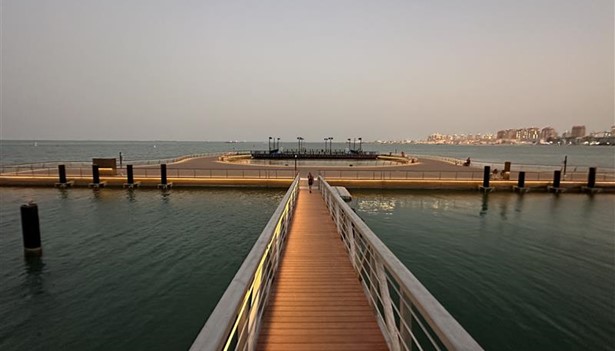
The way to sustainable and resilient future.
We are working towards demonstrating that building on water can create new land for coastal cities looking for sustainable ways to expand onto the water, while adapting to sea level rise. The longstanding vision for building on water is gradually making its way to become the urban future in the hope to tackle the contemporary urban issues and create sustainable resilient future together.
There is no Planet B for us. We need to use wisely what we already have on this only one. Embracing the potential of the blue vastness and sustainable building on water and is a possible way to do so.
Are you ready to flip your perspective and look to the Earth from the other side and explore new humanity's frontiers?